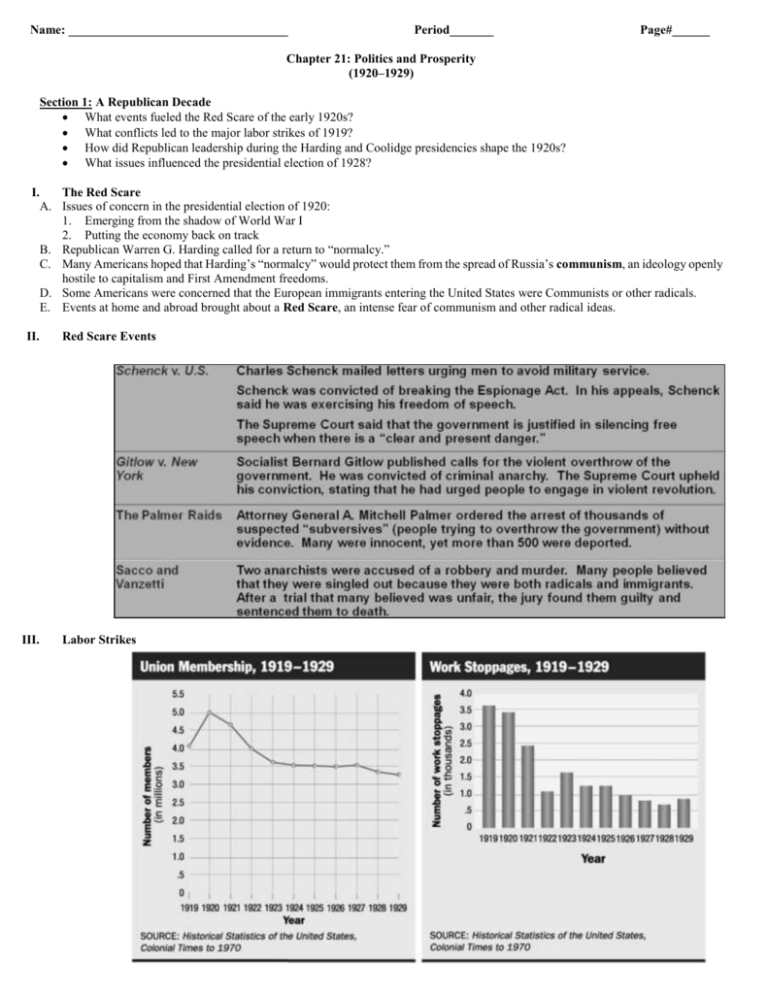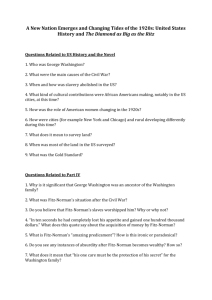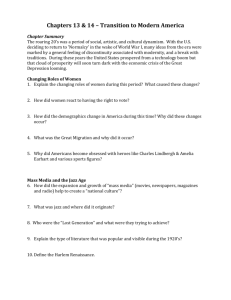Chapter 21 notes
advertisement

Name: ___________________________________ Period_______ Page#______ Chapter 21: Politics and Prosperity (1920–1929) Section 1: A Republican Decade What events fueled the Red Scare of the early 1920s? What conflicts led to the major labor strikes of 1919? How did Republican leadership during the Harding and Coolidge presidencies shape the 1920s? What issues influenced the presidential election of 1928? I. II. III. The Red Scare A. Issues of concern in the presidential election of 1920: 1. Emerging from the shadow of World War I 2. Putting the economy back on track B. Republican Warren G. Harding called for a return to “normalcy.” C. Many Americans hoped that Harding’s “normalcy” would protect them from the spread of Russia’s communism, an ideology openly hostile to capitalism and First Amendment freedoms. D. Some Americans were concerned that the European immigrants entering the United States were Communists or other radicals. E. Events at home and abroad brought about a Red Scare, an intense fear of communism and other radical ideas. Red Scare Events Labor Strikes IV. The Harding Presidency V. A. B. C. D. E. The Coolidge Presidency Coolidge assumed the presidency after Harding died. He summed up a major theme of the Republican decade: “The chief business of the American people is business.” Coolidge supported a laissez-faire approach to business. His economic policies helped fuel the economic boom of the 1920s. Coolidge wanted peace and stability without getting the United States too deeply involved in other nations. Secretary of State Frank B. Kellogg worked with the French foreign minister to create the Kellogg-Briand Pact. Under this pact more than 60 nations agreed not to threaten each other with war. Unfortunately, there were no provisions for enforcement, and many of the countries that had signed the pact would be at war with each other by 1941. Section 2: A Business Boom What role do businesses and consumers play in a consumer economy? How were Henry Ford and the automobile important to the 1920s? In what ways did industrial growth affect the economy of the 1920s? Why did the economic boom bypass some people and benefit others? I. A Consumer Economy A. The 1920s saw the development of a consumer economy, one that depends on a large amount of spending by consumers. B. Until the 1920s, middle-class Americans generally paid cash for everything. Manufacturers developed installment plans and clever advertising to encourage consumers to buy on credit. C. Many new electric appliances created a surge in demand for electricity. Between 1913 and 1927, the number of electric power customers quadrupled. D. By the 1920s, marketers developed a new approach to advertising. Advertisers used psychology to appeal to consumers’ emotions and insecurities to sell products. E. As consumption rose so did productivity. A measure of productivity is the Gross National Product (GNP). The GNP is the total value of goods and services a country produces annually. F. Productivity rose to meet consumer demand, but it also rose because the nation developed new resources, new management methods, and new technologies. II. Ford and the Automobile A. In 1896, Henry Ford perfected his first version of a lightweight gas-powered car. He called it the “quadricycle.” The improved version was the Model T. B. Ford wanted to produce a large number of cars and sell them at prices ordinary people could afford. C. To sell less expensive cars, he adapted the assembly line for his factories. An assembly line is a process in which each worker does one specialized task in the construction of a final product. D. Ford’s success came partly from vertical consolidation—controlling the businesses that make up the phases of production. E. Ford was a complex businessman. His pay rate was very generous, but he used violence to fight unions. III. Industrial Growth and Bypassed by the Boom A. Industrial Growth 1. Automobile making became the nation’s largest industry. 2. Thousands of new businesses arose to serve automobile travel. 3. Other non-automobile-related industries grew as well. 4. Limited government regulation (laissez-faire policies) helped the value of businesses to soar. 5. Rapid business expansion opened up opportunities for small companies. B. Bypassed by the Boom 1. Some Americans struggled to survive during the 1920s. 2. Many unskilled laborers remained poor, and their wages and working conditions did not improve with the boom. 3. Agricultural industries had expanded to meet wartime needs but later failed to uncover new markets. 4. Railroads suffered from shrinking demand, mismanagement, competition from trucking firms, and labor unions that fought against layoffs and wage cuts. Section 3: The Economy in the Late 1920s Why did the economy of the late 1920s appear healthy to most Americans? What danger signs were present in the economy of the late 1920s? I. II. III. Economy Appears Healthy A. Herbert Hoover won the 1928 election, benefiting from the years of prosperity under previous Republican presidents. B. Americans had unusually high confidence in the economy in the 1920s. People made risky investments based on the popular notion that everyone ought to be rich. C. Many employers believed that they could prevent strikes and keep their productivity high with benefits that would meet and exceed the demands of workers. This approach to labor relations is called welfare capitalism. D. Under welfare capitalism employers raised wages, provided paid vacations, health plans, recreation programs, and English classes for recent immigrants. They even set up “company unions” to hear the concerns of their workers. E. As a result of welfare capitalism, organized labor lost members during the 1920s. Economic Danger Signs Personal Debt and Income Distribution in the 1920s Key People, Terms, and Questions: Define the following terms and answer the questions in complete sentences on a separate sheet of paper. NOT all answers are found in the notes; you will have to use your textbook to answer some of the questions. Section 1: A Republican Decade communism isolationism Teapot Dome scandal Red Scare disarmament Kellogg-Briand Pact quota Why did communism seem to pose a threat to capitalist nations? How did the Red Scare contribute to America's policy of isolationism in the 1920s? What was the Teapot Dome scandal? What was the Kellogg-Briand Pact and how did it reflect Republican foreign policy in the 1920s? Section 2: A Business Boom consumer economy Installment plan Gross National Product (GNP) assembly line buying on margin What conditions made a consumer economy possible in the 1920s? What is an installment plan? How did the Gross National Product change during the 1920s? How did Henry Ford change his assembly line to increase efficiency? Section 3: The Economy in the Late 1920s welfare capitalism What reasons did corporations have for practicing welfare capitalism in the 1920s? Why was speculation in the stock market so popular in the 1920s? How does a stockbroker profit from an investor buying on margin? speculation







